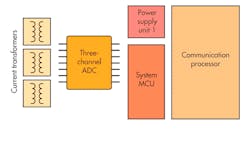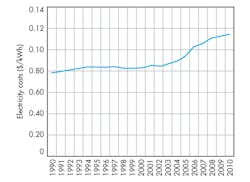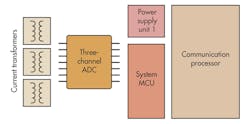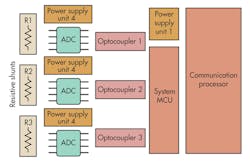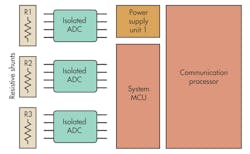Various trends are leading to an increase of electricity theft worldwide. The rate of theft does not seem to be very large, though the cumulative effect on utilities is significant. Electricity meter standards bodies like the International Electrotechnical Commission (IEC) and the American National Standards Institute (ANSI) have developed requirements to prevent meter tampering and minimize electricity theft. But the standards are not always effective, and sophisticated users can circumvent the safeguards.
Related Articles
- Tamper-Proofing The Smart Grid
- You Can't Have The Smart Grid Without Smart Meters
- Security In Smart Meters
A convergence of precision converters and chip-scale transformers is driving better electricity meter design and stronger protection from a common form of theft: tampering with a smart meter by using an external magnet so the meter undercounts or stops working altogether. When these technologies are leveraged, semiconductor vendors can offer ICs for energy measurement applications that combine precision analog-to-digital converters (ADCs), digital isolation for data channels, and isolation for dc-dc power conversion.
The resulting energy measurement ICs are inexpensive and can be offered in a single low-profile package that ultimately enables a new class of smart meters that are completely immune to magnetic tampering. Electric utilities that begin deploying smart meters with these underlying technologies will see a decreased rate of electricity theft and an increase in their long-term revenue.
This file type includes high resolution graphics and schematics when applicable.
The Problem
Most shoplifters are amateurs, but some sophisticated individuals and groups make their living from shoplifting. Shoplifting penalties are typically less severe than penalties for other types of theft, and apprehension and prosecution often are difficult. Some retailers in the U.S. report that shoplifting has a significant effect on their bottom line and that about 1% of all inventory disappears to thieves. This may seem like a low percentage, but experts have estimated that shoplifters cost all U.S. businesses over $25 million a day.
In many respects, electricity theft is a lot like shoplifting. Some thieves are individual consumers who learn how to steal from their utility through the Internet, while others are complex enterprises involved in illegal drug cultivation. The costs to utilities associated with pursuing suspected energy crimes are often far higher than the revenues recovered. Also, laws and regulations only establish a limited obligation on utilities to combat electricity theft.
In the U.S., the industry consensus is that electricity theft costs utilities between 0.5% and 3.5% of annual gross revenues. Again, this level of theft rate seems low, though in one year it can amount to over 1 TWh of generated electricity or over $100 million in lost revenues. In other countries with weaker governance factors, the rate of electricity theft is estimated to be as high as 20%.
There are two important differences between shoplifters and electricity thieves. First, the commercial establishment is a single local utility company instead of a group of different retailers. Second, the pool of potential criminals is much larger and more distributed than consumers who shop at local retailers. In other words, the potential for economic harm is concentrated at the utility, and the beneficiaries are widely dispersed and challenging to catch.
Several recent trends have contributed to the emergence of electricity theft as a serious worldwide problem. Many utilities started off as state-owned monopolies where efficiency and profits were not the highest priorities. During the last several decades, many governments have privatized energy infrastructure and improved energy policy so utilities must operate efficiently and optimize profits. As a result, utilities have a greater incentive to address electricity theft and protect their revenue.
Also, electricity prices have been rising primarily because of cost increases for raw materials such as oil and coal used during electricity generation (Fig. 1). During the last two decades in the U.S., average electricity prices have increased by about 2% annually from $0.078 per kilowatt hour in 1990 to $0.114 per kilowatt hour in 2010. Poor macro-economic conditions have compounded the situation because during times of economic hardship, some consumers and business are more inclined to steal electricity.
Technical Standards For Smart Meters
Utility companies all around the world have known about electricity theft for years and have established a variety of technical requirements for electricity meters that are intended to prevent meter tampering and minimize theft. The International Technical Commission, which is the official body that creates international electricity meter standards, developed a specification for static electricity meters that covers accuracy classes of 0.2 and 0.5.
Document IEC62053-22 has an entire section that describes “influence quantities” that can impair meter accuracy. It includes effects that may occur during tampering such as reversing the sequence of the phase voltages, applying an external ac or dc magnetic field, or applying electromagnetic RF interference.
More specifically, IEC62053-22 states that for a class 0.2 meter, an external ac magnetic field with a strength of 0.5 mT can cause an error no larger than 0.5% from the true measured value. It also defines what the test requirements are and describes all of the reference conditions needed to confirm the meter is complying with the specification.
The American National Standards Institute has developed a similar specification that defines electricity meter tampering events and establishes how meters must maintain correct operation and accuracy. Document ANSI C12-20-2002 includes a section that addresses conditions that can coincide with meter tampering such as applying an external magnetic field or subjecting a meter to external electromagnetic interference (EMI) or radio frequency interference (RFI). The allowable error limit for the ANSI specification is ±1.0% deviation from the true measured value.
In addition to these baseline standards, many countries add specific requirements that address the energy theft problem. In India, a regional specification defines 25 unique tampering schemes that a meter must detect. A regulation in Germany establishes a very challenging dc magnetic immunity limit: an electricity meter must maintain its accuracy even when a 1.2T magnet is applied on all of the meter’s housing surfaces. Many other countries have additional requirements intended to supplement IEC or ANSI meter standards. In summary, industry stakeholders are well aware of the problem and are investing significant effort developing technical standards to minimize electricity theft.
The Convergence Of Innovative Technologies
Before describing new technologies, its important to understand the fundamental building blocks of a smart electricity meter (Fig. 2).
Input sensors transduce a large input signal level to something small that will be compatible with the rest of the system. An ADC creates a bitstream for further processing. Isolation is required in many specific meter standards and regions. A system microcontroller computes all of the energy measurement quantities, such as watt, Irms, Vrms, and VAR. Finally, a communications processor ensures that energy measurements and control instructions can be exchanged between the back office of a utility and the point of consumption.
Two common approaches for polyphase meter design differ depending upon how isolation is implemented in the system. One design approach uses current transformers (CTs) for the input sensors because they provide galvanic isolation and are good for measuring a wide range of input currents (Fig. 3).
A second design approach uses optocoupler technology, which can be small and inexpensive (Fig. 4).
Chip-scale transformer technology now makes it possible to isolate not only data channels but also the power domain so the system can be completely separate. With its very small size and very high manufacturing reliability, it can be combined with other smart meter blocks all within the same IC package. The result is a new polyphase smart meter architecture (Fig. 5).
When semiconductor suppliers leverage chip-scale transformer technology and advanced converter technology within the same IC package, smart meter systems achieve a new level of integration, performance, and reduced overall cost. It is relatively easy to tamper with a CT by placing an external permanent magnet close by, ultimately causing the smart meter to undercount or stop working altogether.
Chip-scale transformer technology eliminates this common method of electricity theft, so utilities no longer suffer from lost revenue. With the new level of integration available today, it is no longer necessary to use external current transformers as the sensor type for smart meters. Not only are CTs prone to tampering, they are also large, heavy, and expensive, particularly if they are dc-tolerant.
How do smart meters with isolated ADCs compare with ones that use external optocoupler technology? The biggest benefit is that with isolated ADCs, the system becomes much more reliable because there are fewer components. Note that the optocoupler design requires at least six extra components: three power supply units for each of the three phase currents (PSU2-PSU4), and three discrete optocoupler ICs that provide galvanic isolation for each of the three phase currents (OC1-OC3).
Eliminating the extra components within a smart meter makes it easier to manufacture and improves long-term reliability. This is important since smart meters must operate properly in the field and maintain their accuracy in harsh environments for years. When smart meters incorporate isolated ADCs, component count goes down while long-term reliability goes up, utlimately translating into lower operating expenditures for the utility.
Conclusion
Electricity theft is an increasingly vexing problem for utilities. However, a convergence of innovative technologies is driving better electricity meter design and stronger protection from theft using an external magnet. Precision converters and chip-scale transformers can be combined within the same IC package to enable a new class of smart meters. These smart meters of the future are completely immune to magnetic tampering. Electric utilities that begin deploying smart meters with isolated ADC technology will see a decreased rate of electricity theft and an increase in their long-term revenue.
About the Author
John Pitrus
Product Marketing Manager for Energy Management Products
John Pitrus, product marketing manager for energy measurement products at Analog Devices, is responsible for addressing growing technology needs in the Smart Grid and related areas. He works closely with customers to address requirements for electricity metering and emerging energy measurement applications. He received a BS in computer and systems engineering from Rensselaer Polytechnic Institute in 1985 and an MBA with a concentration in marketing from the University of Chicago Booth School of Business in 1991.
